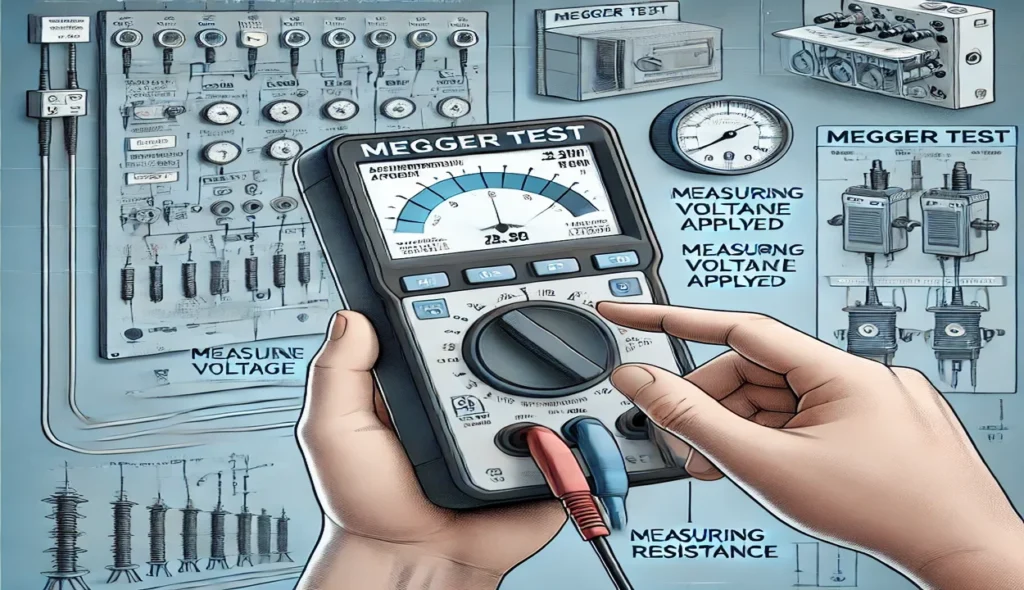The Megger test is a widely used method for testing the insulation resistance of an electrical system. Over the years, its purpose has remained the same, ensuring safety by detecting any leakage or degradation in insulation. The instrument, often named a tester, applies D.C. voltage across its probes, calculating the IR value automatically. This method is crucial in avoiding fatal electrical hazards by identifying potential shock risks. The test is popular due to its easy operation and high accuracy in detecting mechanical or environmental impacts on electrical equipment.
Over time, insulation degrades due to humidity, moisture, temperature, and other environmental factors, which can negatively affect the insulator’s condition. The presence of stress, whether electrical or mechanical, further weakens it. To verify the real state of insulation, regular checking at fixed intervals is necessary. The Megger test is impressive in detecting weak spots and is synonymously linked with insulation resistance testing. Measured values help in deciding whether the equipment can withstand its service voltage without risk. By keeping records over a long period, one can predict recent deterioration and plan maintenance effectively.
The idea of the Megger test is not new; it was first introduced in 1889 and gained popularity around the 1920s. Since then, improvements in design and quality have made it even more reliable. With high-voltage applications, the test must be performed with caution to ensure safe handling. The device works by displaying results instantly, making it a valuable tool for electrical maintenance. Modern testers come with various options, offering automatic functions to ensure precise readings. By regularly using the Megger test, one can maintain the enduring power of electrical systems and prevent costly failures.
 Importance of Megger Testing
Importance of Megger Testing
Megger testing is crucial for detecting insulation failures in electrical systems before they lead to serious problems. Over time, deterioration of wiring occurs due to environmental factors such as temperature, dust, and moisture. The presence of stress and mechanical wear can also cause leakage in the system. Regular testing helps prevent shock and unexpected failures by checking the condition of electrical insulation.
When a fire or an explosion happens, the extreme heat can compromise the integrity of the wiring system. In such cases, the insurance company may require a Megger test to verify whether the electrical system is still safe. This ensures that the walls, attic, and other hidden areas are free from damaged or compromised wires. Without proper testing, unseen electrical faults may create another hazard.
Electrical resistance changes when insulation is weak or has punctures. The flow of current through a weak area can generate excessive heat, which might reach the melting point of metals and lead to another fire. The Megger Test detects such risks by applying 500 to 1,000 volts to locate faults in insulation. It is an effective way to detect unseen faults behind walls or in hidden spaces.
Public safety regulations and jurisdiction rules often require this test to ensure electrical integrity. The Electric Company might also mandate a Megger Test before restoring gas and electric services after an incident. This step is crucial in the rebuilding process of a home or business after electrical damage. Neglecting this required test can result in potential hazards that may remain undetected.
Unlike destructive methods that create holes in walls, a Megger test is a non-invasive option for checking electrical insulation. The device measures resistance and identifies faults without causing structural damage. However, some minor issues may go undetected if the applied voltage is too low. Despite this limitation, it is still an essential tool for maintenance and safety checks.
Regular testing at fixed intervals is necessary to prevent sudden failures and maintain the quality of the electrical system. Whether in homes or industries, ensuring that electrical insulation remains intact helps avoid risks. The course of action taken based on the Megger test results can prevent major electrical failures. By maintaining electrical integrity, this test plays a key role in overall safety and efficiency.
Process of Megger Testing
During Megger Testing, electrical circuits are thoroughly analyzed to detect fault areas that may have occurred due to a fire or other events. The process helps identify melted wiring and connections that need to be isolated and replaced to ensure safety. Once the test is performed, the results are carefully logged and filed for review by the Local Building Department or an insurance provider. This step is often required to verify the condition of the existing electrical system and prevent further problems.
Electrical professionals, such as those at Carelabs, have the expertise and proper equipment to perform accurate testing. If damage is found, they assist in installing safe and functional wiring to meet insurance and carrier requirements. Property owners should consult their adjuster to check if their claim is covered and whether Megger testing is a necessary step to reclaim their domicile. Taking this precaution can help avoid future electrical hazards and ensure compliance with department regulations.
Procedure for Megger Testing
To perform Megger testing, an insulation tester is used to measure the insulation resistance of an electrical system. This test helps in detecting any leakage in cables, wires, or equipment that may have been overloaded or exposed to moisture. Unlike a multimeter, which only checks continuity, this instrument applies electric voltage to identify faults. The test is carried out under different conditions to ensure accurate results and verify the level of insulation.
This method is popular for testing motors, generators, and other electrical installations to confirm they are in normal working order. The tester determines the amount of leakage and whether the winding or insulation has suffered any puncture. While it may not always show the exact area of damage, it provides reliable data for maintenance. This test is necessary to ensure electrical safety and is often performed at long intervals to check system health.
Step-by-Step Process of Insulation Resistance Testing
The procedure for the Megger test starts by disconnecting all terminals from the transformer or electrical equipment. The leads of the tester are then connected to different points such as LV and HV bushing studs to check the resistance between the windings and earth. The test applies voltage based on the rating, typically 5000V for 33kV cables, measuring the IR min value in MΩ. This helps to determine whether the wire insulation is intact or has deteriorated over time.
The measurement process involves testing between phases, individual phases, and between the body and ground of the circuit. The test detects if a motor or other appliances have become shorted due to faulty insulation. Readings can range from 1 GigaOhm to 200 GigaOhm, depending on the size and levels of insulation. An empirical equation like IRmin = kV + 1 is used to calculate the minimum expected value based on the rated service voltage.
The applied voltage varies based on the conducting material and insulation strength.
If the measured resistance is below the minimum, insulation may be deteriorating or damaged.
A multimeter cannot provide accurate insulation resistance readings like a Megger test.
The test ensures that the wire remains protected and safe from leakage or faults.
By performing this general testing, electrical safety is ensured, reducing risks in buildings and appliances. Regular testing prevents failures in high-voltage circuits and extends the lifespan of electric systems. The procedure is reliable, detecting insulation breakdowns before they cause major electrical issues.
Working Principle of Megger Test
The Megger test works on the principle of electromagnetic induction, generating a testing voltage to measure resistance in an electrical circuit.
In a hand-operated tester, a crank is rotated to generate DC voltage, while in an electronic-type tester, a battery is used to produce the voltage.
The voltage range depends on the application, typically 500 volts for 440-volt circuits and 1,000 V to 5,000 V for high-voltage systems.
A deflecting coil and a control coil work together to measure current flow, with the pressure coil connected across the circuit.
The current coil allows electric current to pass, and a current-limiting resistor (CCR or PCR) is used to protect the circuit from damage if the resistance is too low.
The armature moves in a permanent magnetic field, creating the effect needed to measure insulation strength.
If the circuit is open, the pointer on the tester moves to infinity, showing maximum resistance and no shorting in the circuit.
If there is a short circuit, the pointer moves to zero, meaning there is no resistance and the insulation is completely faulty.
As the voltage increases, the deflection of the pointer also increases, showing the corresponding insulation level.
The resultant torque is proportional to voltage and inversely proportional to electric current in the circuit.
The tester is widely used for performing insulation checks on electrical equipment, ensuring proper safety.
This test helps maintain insulation quality in external circuits, preventing potential failures and hazards.

Types of Megger Test
Manual Type (Hand Operated)
Electronic Type (Battery Operated)
Benefits of Hand-Operated Megger Test
No battery or external source is needed to operate, making it much cheaper and more reliable.
The method is widely accepted for testing insulation resistance in electrical systems.
Engineers use it to check IR test values in transformers, motors, and winding insulation.
A hand-operated megger test is simple to use and does not require an energized circuit. Unlike motor-operated testers, it works without an applied power source, making it ideal for quick inspections. It is the oldest and still acceptable technique for detecting low-resistance faults in an insulation system. This is why it remains a preferred choice in various maintenance tasks.
The comparison of results from this test with standard values ensures the accurate determination of insulation quality. It helps detect moisture, contamination, and deterioration in electrical components. Since it does not need test voltage from an external supply, it is useful in remote areas. Engineers rely on it as a general tool for checking insulation health.
Regular testing with this device ensures that power systems remain safe and functional. The recorded data helps in future repair work by identifying changes in insulation conditions. It is an essential tool for checking humidity-affected insulation and dirt accumulation in windings. The rule of thumb states that a minimum of 1 MΩ per 1000 V is needed for safe operation.
Benefits of Electronic Type Megger Testing
IR value is displayed in a digital format, making it easy to read and interpret.
The device ensures high accuracy, providing reliable insulation resistance measurements.
It is handy and can operate efficiently, even in congested spaces where movement is limited.
Only one person is required to use it, making the testing process easily manageable.
The tester works perfectly and remains safe, ensuring that insulation tests are done without risk.
Essential Safety Measures for Megger Testing
Always de-energize and discharge the circuit completely before connecting the megger test to avoid electric shock.
Disconnect the item being checked from other circuitry, if possible, before using the tester.
Never touch the test leads while the handle is being cranked, as it may result in serious injury.
Use the megger test only for high-resistance measurements, such as insulation testing or to check separate conductors in a cable.
Ensuring safety during a megger test is crucial to prevent electrical hazards. Before connecting the tester, always de-energize and discharge the circuit. This eliminates any stored charge that could cause harm. Handling the test leads properly and keeping a safe distance while the handle is cranked reduces risks.
It is also important to disconnect the item being checked from all other circuitry before using the tester. The megger test is designed for high-resistance measurements, such as checking insulation or identifying faults in separate conductors within a cable. Following these precautions ensures accurate results and safe operation.
Key Benefits of Megger Testing
Proactive Equipment Condition Analysis helps identify insulation issues before they lead to major failures.
Reduced risk of electrical faults ensures that power systems remain stable and reliable.
Insured availability of equipment means minimal downtime and continuous operation.
Predictive Repairs allow early detection of faults, preventing costly breakdowns.
Asset management improves by tracking insulation conditions and extending equipment life.
Predictive Equipment Life Expectancy helps to plan maintenance schedules efficiently.
Conclusion
The Megger Test checks the insulation resistance of electrical systems. It helps ensure safety, reliability, and efficiency. It uses electromagnetic induction. Hand-operated or electronic testers create voltage and measure resistance. This test helps in detecting faults, preventing short circuits, and reducing the risk of power system failure.
Users can perform high-resistance measurements accurately by following safety precautions. This includes de-energizing circuits and handling test leads carefully. Both hand-operated and electronic-type testers offer benefits. They are useful tools for engineers and maintenance workers. Regular testing helps check equipment conditions early. It leads to smart repairs and improved asset management.
It plays a crucial role in maintaining the predictive equipment life expectancy of power systems. Whether for routine inspections or diagnosing potential failures, this test remains a trusted solution in the electrical industry.

 Importance of Megger Testing
Importance of Megger Testing
